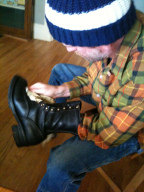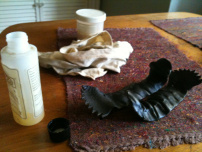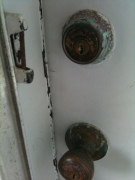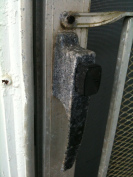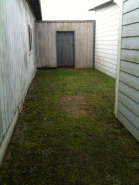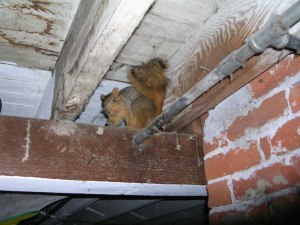Kristy Athens's Blog, page 11
February 24, 2013
Winter Is Only as Bearable as Your Boots
One day in November, on the same day that Mike and I attended to our pile of mending, Mike also prepared his boots for winter. I tend to treat mine when I put them away for the summer, but Mike wears his all year and waterproofs them right before winter sets in.
When we were on the farm in Washington, Mike invested in a pair of Wescos. There are a number of high-quality companies across the United States, places where skilled craftspeople still make their footwear by hand. West Coast Shoe Company is one of them. Favored by loggers, welders and motorcyclists, they are built to last.
When Mike bought his Wescos at their showroom in Scappoose, Oregon, they didn’t offer high-tech silicon sprays or other chemical compounds; they gave him a bottle and a jar of beeswax-based sealants. Every fall, he rubs the solid beeswax into the leather, and then he drips the liquid wax onto the stitching, tilting the boots slowly so it soaks into every crevice. He removes the laces and false tongues, and covers every centimeter.
We try to be a family that values quality over quantity; neither of us owns very many pairs of shoes and boots, but we own good ones. The process of caring for them reconnects us with each piece of leather, from the backstay to the toe cap. Refreshing shoes that are not meant to last one season and then be thrown away (or donated to a charity, the guilt-free way to throw things away …), but a lifetime, makes us feel like we’re at least putting a dent in our global impact. And the shoes reward us by keeping our feet warm and dry for another season.

February 17, 2013
Sexual Violence Culture
A couple of months ago I read about a rural Oregon woman, 21, who was asked by her 24-year-old neighbor, whom she knew, for a ride into town. Once in the car, the man pulled out a gun and ordered the woman to drive into the mountains, where he sexually assaulted and then murdered her. Readers’ comments beneath this online article shrugged off the episode either because of where the woman and man live, or because the woman allegedly had a “reputation.”
Once at the gynecologist’s office in rural The Dalles, Oregon, I was filling out an intake questionnaire for an annual exam. Because I am a writer and, by nature, think about big-picture things, I answered the question “Have you ever received unwanted sexual advances?” with “Hasn’t everyone?” The doctor did not appreciate that I was being philosophical; she spent ten minutes asking a series of pointed questions until I assured her that I was safe in my home.
I’ve done no research to back this up, but I think it’s safe to say that anyone and everyone, female or male, experiences an unwanted sexual advance at least once in their lives. A stare, a brush-up, an inappropriate comment. I write this not to decrease the seriousness of harassment but to out it as a problem for everyone, not just “white trash” or “sluts.”
When it comes to more serious advances, the perpetrator is usually someone the victim knows. In a rural area, this gets especially tricky because the victim will probably also know the perpetrator’s family, and they hers. Most rural cultures still revolve around traditional male and female roles, which can lead to women being doubted when accusing a man of sexual assault and can cause women to not report a crime at all, because the prosecution of the rapist might affect a family member’s or friend’s ability to pay their bills. This can make bringing a rapist to justice—if it is even attempted—a protracted, ugly affair.
I did some editing work for a domestic violence shelter in the same town my doctor’s office was in, and learned a lot. The executive director, Tara Koch, is a tireless advocate for people who want to leave violent and/or abusive relationships, and her staff and volunteers are brave supporters of them, collecting food, household items and money. She and her staff have an uphill battle.
Rural law enforcement officers do not always have the training to understand and appropriately deal with domestic violence patterns and issues. They usually lack resources to investigate domestic violence calls, and are physically at risk when they investigate them, especially when answering calls to remote, secluded homes. And they may have personal conflicts of interest, or convictions that are at odds with the rights of women.
Discussing domestic violence can be uncomfortable. But the more stories are told, the more women will realize they do not have to bear the burden of sexual assault and domestic abuse alone, and more abusive men will realize it’s no longer something they can get away with. Doing nothing will only allow it to continue.

February 10, 2013
Death Hill
While we lived out on our land, we had lots of visitors—from Seattle, Wisconsin, Texas, Minnesota, and even Germany! And, of course, dozens from Portland. Some came to help us with farm projects and some came just to play. One of our most frequent visitors was our friend, Laura Ross.
Laura would drive out to visit in her decrepit Volvo station wagon with a grocery bag full of steaks and whiskey. In 2004 spent New Year’s Eve with us. Little did we know she would stay a few extra days! The Gorge was hit with a huge snowstorm that weekend, and the road back to Portland was closed. But, as I mentioned in my recent post on Tattered Cover Books’ blog: when it snows lemons, you make frozen lemonade!
Tuesday is Laura’s birthday, so Mike and I (mostly Mike) whipped up a little video from that weekend. Laura makes her very first snow angel!
Happy Birthday, Laura Ross!


February 3, 2013
Life on the Beach
As you think about where you want to put down your rural-life tent stakes, consider what kind of town appeals to you. In Get Your Pitchfork On!, I describe some of the archetypal towns in the rural United States. Farm towns, ranching towns, sports towns … coast towns. I specify “fishing towns” in the book to differentiate them from “tourist towns.” Most fishing towns are on a coast, but not all towns on a coast are fishing towns.
Visiting the coast is very different from living there. Walking your dog on the beach can be serene and relaxing on a still, 70-degree morning during your summer vacation—not so much on a blustery 40-degree morning in February with rain blowing sideways. Coast-dwellers wear knee-high rubber boots and hooded jackets for a reason.
The thing that all coastal towns have in common are the unique conditions related to the land’s proximity to the ocean. The water carries caustic salt and is in constant flux due to the tides and the prevailing winds. The temperatures tend toward moderate, with less fluctuation between the highs and lows. However, on some beaches, cooling summer breezes quickly disappear once you go inland, even a short distance, leaving you sweltering in your “coastal” home.
Any time I am on the coast I marvel at its fantastic ecosystems. Miles of sand. Cliffside trees that are permanently bent inland due to the constant pressure of the wind. Colorful starfish and anemones in tidal pools. Sea lions cavorting in the surf. Not to mention the unique worlds of brackish estuaries and coral reefs.
Not all coasts are the same—the beach in Maine is nothing like the beach in Florida. Even the Gulf coast of Florida is different from its Atlantic coast, and its northern climate different from the Keys. Because I live in Oregon, I can best speak to its coast. Last month, my husband and I drove to Pacific City for a few days of R&R. The house we rented was right on the beach—we didn’t even have to cross a street to get to it, just walk out and over a dune.
But the mark of living “right on the beach” was all over this house.
The wind drives sand and salt air inland on a nearly continual basis and, because of that, everything made of metal—every light fixture, every doorknob, every hinge—was corroded. The windows were coated with a salty sheen.
The homeowner had built a wall between his and the next house to keep sand from filling the gap. The dune that had built up behind the house had been partially removed earlier in the year.
Further down the beach, hydraulic shovels were doing the opposite—building up the dune to keep storm surges from washing away the foundations of some homes that were a little too close to the water.
If you move to the coast and raise children, there is a good chance they will take up ocean sports. Be sure you and they understand the safety issues—rip currents, for example, are far more dangerous than sharks, sneaker waves or any other hazard.
I once was hiking along some boulders near a jetty with some friends. There had been a big storm the night before, and sand and jetsam were washed over all the rocks. I leapt from a tall boulder to a large, flat one. Instead of landing on hard rock, however, this particular boulder jiggled. I couldn’t get off it fast enough. JEEBUS-FRICKIN-GRAVY!! It was not a rock at all, but a sea lion carcass. I was very lucky to not break through the skin.
Depending on how close you live to the water, the constant roar of the ocean may become part of your daily life, so make sure you love it. I mention in GYPO a young girl who lives in Frenchglen, Oregon, one of the most remote settlements (can’t really call it a town) in the United States. She went to the ocean on a field trip with her class, and the noise made her feel crazy. She couldn’t wait to return to the silence of her pacific high-desert valley.

January 27, 2013
Glutton for Publishment
Two years ago, I was in the middle of pitching my Get Your Pitchfork On! manuscript to prospective publishers. Whoever thinks writers are pale, weak, sensitive creatures lounging on our fainting couches has obviously never seen us get rejection note after rejection note. Hunching over a desk in a poorly lit room and writing is one thing—publishing altogether another. In fact, I used to teach a how-to-get-published workshop called “Glutton for Publishment.”
Because I am one these gluttons, I have been sending my work out for more than 20 years. I don’t take rejection personally; every editor has his/her own taste and mission with their publication. What might inspire someone one day might annoy them the next. Every once in a while, I get a bite! Being published by someone is a combination of good writing, good timing, and good luck.
So, I was absolutely thrilled when Adam Parfrey of Process Media contacted me to ask for more than my sample chapter to review! And then, when he sent me a contract! I was so happy I kissed it.

Kristy makes out with her contract
With Get Your Pitchfork On! closing in on its first full year—after lots of reviews, interviews and articles written about and by me—one might think that the novelty of seeing my words in print might have worn off. On the contrary! Every time I write a new piece, the joy of seeing it enter the world begins anew.
Which brings me to Thursday last.
Thursday was a banner day, beginning with a guest blog post on the site of Denver’s illustrious Tattered Cover Book Store:
http://tatteredcoverbookstore.blogspot.com/2013/01/a-special-guest-post-from-author-kristy.html
In it, I describe the travails and benefits of living in a place with snow. A lot of snow.
And later in the day, HandPicked Nation ran the first of what will hopefully be many excerpts of this blog and the book itself:
http://www.handpickednation.com/making-value-added-goods-from-the-farm/
(Posting this may create some kind of blog-vortex, since their page sends you back to July’s original post.)
Some people save their rejection notes in a shoebox; some paper their walls with them (this is becoming more difficult with the triumph of email over snail mail). I recycle them and focus on the pieces that made it through all the hoops.

January 20, 2013
Squirrel Eviction
Mike and I recently returned from a mini-vacation to find chaos in the basement: jars knocked from a shelf; hangers askew; insulation bits all over the floor. However, there was no sign of intrusion—all the doors and windows remained intact and locked. This could mean just one thing: a critter. Because all the damage came from up high, we assumed it was a squirrel.
It was late and we were tired, so we tried the easy solution—opening the door to the outside and going back upstairs. Before retiring, we closed it up again and hoped that would be the end of it.
The next morning, I woke to the sound of some scritchy-scratches under the floorboards. Mr. Critter was still on the premises.
Commence half-asleep comedy routine: I rose, put on my eyeglasses and slippers, and went downstairs. I hadn’t bothered to dress, nor remove the mouthguard I wear at night that makes me lisp and look like I have rabbit teeth. I crept down the stairs in my pajamas and opened the door to our backyard.
I continued slowly to the basement, which is divided into fourths. In the middle of the front “rooms” are the furnace and hot water tank. The back rooms have sliding doors. I didn’t see anything in the half I was in, so I made my way carefully over to a baseball bat and then opened the sliding door to the room below our bedroom. Nothing there, so I closed the door behind me. Perimeter ¼ secure.
I went back around the water heater to get to the far side of the basement. As I approached the sliding door to that room, a commotion erupted above my head—the squirrel was in the rafters, dodging along a pipe to get away from me. This was good; he was heading toward the open door.
“Hey, Thquirrel,” I said. Both Mike and I have a propensity for addressing animals directly. “You can’t thtay down here.”
The squirrel clung to his pipe and stared at me.
“Go on.” I said. He twitched his tail but didn’t move.
This Grizzly Adams strategy wasn’t panning out; Mr. Squirrel needed a bit more encouragement. I poked my bat in his direction. “Go on, Thquirrel!” I yelled.
The squirrel raced across a cable that was stapled to the rafters toward the other side of the basement. I ducked around him and got behind him, and then whooped and waved my bat in his direction, hoping to send him out the door. Instead, he darted back toward the far side of the basement.
Undaunted, I ran back over there too, got behind him again and commenced to yelling like a cowgirl on the range. “Hup, squirrel! Ha! Get on!” I banged my bat against the rafters and the air ducts.
The squirrel ran toward me! I shrieked and hollered, and he corrected course and holed up above the water heater.
By this time, Mr. Squirrel was also upset. He glowered at the giant demonic lisping rabbit-creature pointing a bat at him, and barked and clucked.
I could hear Mike laughing upstairs.
There needed to be two of us; otherwise, I would just keep chasing the squirrel back and forth all morning. I retreated to the living quarters.
After dressing and eating breakfast, Mike and I prepared for Round 2. We made a plan—I would flush the squirrel toward Mike, and then Mike would flush him out the door.
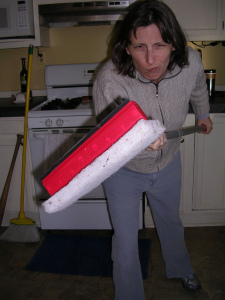
Kristy gets her game face on
We went downstairs. Even though the door remained wide open, Mr. Squirrel was still in the basement. I snuck over to the far side. The squirrel gave a few warning barks.
“Ready?”
“Ready.”
“GO ON, SQUIRREL!” I yelled. I banged the air duct for good measure. The squirrel took off on the cable toward Mike, who yelled and swung his broom. The squirrel missed a step and fell to the floor. He ran straight for the door and then—turned and ran toward Mike, who yelped and jumped in the air. The squirrel climbed some boxes and then dropped behind a section of pegboard attached to two-by-four stringers.
Now he was really mad. He cussed us out from behind the pegboard. We whacked on it a few times to try to scare him out of there. Then, it seemed like he might be stuck.
We pondered our next step.
“I just don’t understand it,” said Mike. “Why didn’t he go outside?”
I understood it. This squirrel wasn’t stupid—why curl up in a pile of leaves suspended in some tree branches when you can lounge in the rafters above a gas furnace?
But also, I looked out the door and cursed. While, yes, we had opened the door, we neglected to move the giant recycling bin that was right in front of it. So the squirrel might have left but when he got close he didn’t see green grass and trees, he saw a blue wall.
Squirrel 2, People 0
We ended up moving the bin, leaving the door open and going for a walk, hoping that A) Mr. Squirrel wasn’t stuck and B) The trauma of this episode might encourage him to leave. We lucked out; he was gone when we returned.
How To Remove a Squirrel from Your House
The best way is to allow/encourage it to leave on its own.
Step 1: Clear the pathway. Look at the escape route from both ceiling and floor level, and block any alternate routes.
Step 2: Wear gloves and have some sort of long implement—not to strike with, just to usher it toward the escape path.
Step 3: Quietly station yourselves on either side of the squirrel if possible.
Step 4: Action! Don’t go crazy but make some noise and use your implement. Be strategic. You want to encourage its Flight instinct and direct it toward the way out. Unless you get too close, you are in little danger of being bitten—the squirrel wants to stay as far from you as possible. Use this to your advantage by occupying areas behind the escape path. That said, don’t corner it, or it may feel that its only choice is Fight. Stay out of any place that will force the squirrel further into the house. The nice thing about a squirrel is it doesn’t want to be on the floor so it’s unlikely to hide under something.
Step 4a: If this doesn’t work, you might have to set a trap.
Step 5: Find its entryway and block it, so you’re not doing this repeatedly. It’s probably on the roof somewhere.

January 13, 2013
Mending Day
Fixing something that is broken, rather than buying a replacement, can be one of the easiest economies in the world. This practice has died out in many American households: People love new stuff so much that they don’t seem to care if it’s low quality. Most Americans would rather have, for example, five cheaply made shirts than one well-made one. When the cheap ones wear out, why, just throw them away and get five new cheap shirts!
Mike and I try to find balance on this topic, as we don’t want cheap shirts and can’t usually afford good ones. One way we compromise is to buy the well-made shirts of yesteryear at a thrift shop. Another is to mend the clothes we have.
At our house, things that need mending sit around until there is a critical mass. Every couple of months, we collect the pile of shirts and stray buttons, pull out the sewing kit, and get to work.
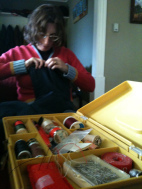 I have had this sewing kit since my seventh-grade home economics class. My mom took me to K-Mart and bought me a matching set of supplies: measuring tape, needles, thimble, seam ripper, and so on, which are red and still bear my surname and class section “08.” I have various colors of thread and dozens of buttons, most of which I acquired at yard sales.
I have had this sewing kit since my seventh-grade home economics class. My mom took me to K-Mart and bought me a matching set of supplies: measuring tape, needles, thimble, seam ripper, and so on, which are red and still bear my surname and class section “08.” I have various colors of thread and dozens of buttons, most of which I acquired at yard sales.
In this photo you can see some of the original items; the pincushion is taped because it’s leaking sawdust!
Unfortunately, I’m about as good a seamstress as I am a cook, so I limit my efforts to maintenance. On this day, Mike had a few buttons to replace and a ripped-out pocket corner to fix, while I was trying something a little more advanced: hemming a pair of pants that a friend had given me. They fit perfectly but were just a bit too long.

Mike fixes his pocket in the least ergonomically sustainable posture possible
First, I used my 30-year-old seam ripper to eliminate the old hem. I put on the pants and Mike helped me determine a good length. Conveniently, the new length lined up with the top of the old cuff, so I didn’t have to pin it. I ironed a crease for the new hem, cut off the extra, and started sewing.

Ironing the new length
Since I don’t have a ton of spools, finding a similar color to one’s sewing project can be a bit of a challenge. Mike made out all right with his plaid shirt, but I don’t have “denim”-colored thread. I decided the best thing, since the finish of these pants is akin to an acid-washed look, was to go light and use a buff-colored thread.
The key, when hemming, is to do most of the sewing on the inside so the hem isn’t visible. That is, on the outside you make the tiniest stitch you can, and then move the needle a quarter-inch or so on the inside of the pant leg. But don’t learn from a hack like me; here’s a tutorial.
Because I lose patience with sewing after about 25 minutes, I only did one row of stitches instead of two. So far, they have held just fine. Doing even this small amount of sewing makes me appreciate the hard work that goes into a piece of well-made clothing, even with a machine! And while no one would give my pants a second thought, I love to wear them and know that I put in a small amount of work and kept one pair of pants out of the new-crap-new cycle.

January 6, 2013
2013 Events
In 2012 I had the good fortune of reading from Get Your Pitchfork On! in a number of bookstores, libraries and other venues. This year, I would like to focus on attending farm-to-table events, homesteading fairs, organic food festivals, and other such events. Do you know of one? Please share it with me via the comments section below, the GYPO Facebook page or email, kristy @ kristyathens.com (no spaces).
And if you’re in Portland on Monday, January 7, please join me and some respected writer colleagues (Jon Bell, Kate Gray, Robert Hill, Gigi Little, Gina Ochsner, Joanna Rose, Scott Sparling and Yuvi Zalkow) at Powell’s Books downtown for a special presentation supporting Brave on the Page, a new book by Forest Avenue Press that is chock-full of essays and interviews about writing, including an interview with me that editor Laura Stanfill posted in May in her blog series, Seven Questions.
It should be an inspiring evening of shop talk, so if you’re a published writer or an aspiring one, please join us at 7:30. There will be copies of GYPO to sign, too!

December 30, 2012
Burying My Dog
Living in a rural place was an exercise in accepting death. Speeding cars and trucks killed dozens of wild animals on the county road at the top of our property; I murdered pests to protect our crops; I killed chickens for food. None of this prepared me for burying my nine-year-old dog, Phynn.
A couple days after Christmas in 2006, I had gotten home from work around 5:30. After changing into “on the farm” clothes and boots I commenced to chipping ice from the path between the garage and the house. I’d had a stressful day at work, and driving the ice chipper into the ground over and over felt really good. Phynn was running around, enjoying the snow. Like any farm dog, she didn’t go far from the house, so when she saw I wasn’t going to play and abandoned me, I thought nothing of it.
Phynn was a smart, good dog. She didn’t chew up our shoes; she didn’t steal food; she stayed off the couches. She understood peeing outside the first day she came to live with us, at eight weeks old. You could speak to her in full, conjugated sentences. She left children and chickens alone—not because she didn’t want to bite them but because she understood we didn’t want her to bite them. She was up to any challenge—skiing, hiking, swimming. She was a good friend.
If Phynn was misbehaving, it was usually in the Forbidden Field. This small triangle of land was stranded by circumstance, belonging neither to us nor our neighbors but to a nearby gravel business. A glorified embankment off the highway, it was often the final resting place of deer and other animals that were hit by cars. It’s hard for a dog to ignore perfectly good roadkill just on the other side of the driveway. This wasn’t dangerous for her, just unsanctioned.
Phynn had been visiting the Forbidden Field a lot that fall. At first she was disappearing for twenty minutes or so, and then returning to the house to collapse on a rug with a bloated belly (I talk about this in Get Your Pitchfork On! in the “Country Dog Fun” chapter). One day, she brought home a nice, gory foreleg. Soon after, she had this odd-shaped thing that smelled like she’d extracted it from Satan’s anus—part of the spine. By that point, snow was falling and the thing was probably too decomposed to bury anyway, so we didn’t try to find it; we just scolded her and confiscated the pieces as they appeared. But she continued to visit.
What happened next is anyone’s guess—maybe there were living deer in the Forbidden Field and she started chasing one. Maybe a coyote ran her off the carcass. Maybe she ran a coyote off the carcass. In any case, while I was clearing our walk Phynn took the liberty of climbing up to the highway.
After a while, I called for her. I was ready to go back inside and make some dinner. Mike was still in Portland, visiting friends who’d had a baby.
It was unusual for Phynn to ignore me. I walked up the driveway a bit and called her, figuring she was debauching herself once again with this carcass. Highway 141, being a country road, is pitch-black at night, and we happened to live on a tight curve that elicited jake-braking from all the log trucks that rounded it.
I called for her again and listened. I heard a ka-thunk; the sound of someone throwing a good-sized stick at a car.
That couldn’t have been her, I thought. But, deep down, I knew it was. Shock set in immediately. I checked the other fields and then walked back to the house, intending, I think, to get a flashlight. Not thinking straight, I grabbed a penlight, one that could handle no bigger job than to change a fuse. When I got to the top of the driveway, it didn’t even illuminate the ground at my feet.
It would have been foolhardy to investigate further. Cars whooshed by at 50 miles an hour; their headlights whirled past me on the curve and their tires raised a cloud of dirty spray. I recalled that the wife of my neighbor, Pete, was struck and killed not twenty feet from where I stood, when she went after one of their donkeys that had gotten loose. I was afraid to take another step.
Maybe that wasn’t Phynn after all, I thought. Maybe she’s in the woods, or at our neighbors’. Though she never went into the woods or to our neighbors’ without us, I walked back to the house, made some soup and waited for Mike to return. When he pulled down the driveway and I didn’t hear her barking, dread resurfaced.
“Where’s Phynn?” Mike said when he came in the house. I told him what I knew.
“I saw something on the road,” he said slowly.
He paced while I finished my soup, but, really, there was no hurry. We already knew. We put a couple of towels in the truck and crawled up the driveway. I scanned the shoulder. Nothing … nothing …
There she was, lying on her side in the icy gravel. Mike carefully pulled in front of her and put the hazard lights on. We walked behind the truck. In the flashing red lights, I could see that her tongue lolled out of her mouth; yet another country thing I’d seen in cartoons as a kid and hadn’t considered actually happens. She was, mercifully, intact—no car had run over her and she hadn’t been there long enough for scavengers to get at her. Her eye was open and glossy black.
Cars occasionally whizzed by, slowing slightly when they passed us. We put Phynn’s stiff body on a towel and then hoisted her into the bed of the truck.
In the garage, we discussed where to bury her. I put a towel under her mouth to collect the blood that had leaked out, and examined her. Her back legs were bent in a run. I tried to collapse her front legs so it would be easier to bury her; one was broken.
We carried shovels to the top of the field. The soil, which set up like concrete during the summer, was mercifully pliable after all the rain and snow that had fallen. Only the very crust was frozen. The air was cold and clear.
We went back down to the garage and carried Phynn up using the corners of the towel she lay on. We took a couple of breaks on the way up the hill; the load was bulky and the snow slippery. Nothing interrupted the silence but an occasional car swinging around our bend in the road.
We put Phynn down next to her grave. I lay in the snow for a while, sobbing and petting her neck, until my legs became numb with cold, and then we laid her in the ground. We walked down to the quiet house.
The next morning, there was one perfect set of paw prints on the deck in the frost, facing the door, as if she had spent the night waiting for us to let her in.

Phynn


December 23, 2012
A Reason for the Season
Every December, my husband Mike and I go out into a stand of pine or fir trees, cut one down and bring it home. We carefully string lights on it and then, one by one, pull ornaments from a storage box and hang them. Many of them have a story, so we tell it. Some of them we’ve had since childhood. Then, arm in arm, we turn off the rest of the lights and enjoy this special, colorful monument.
But it’s not a Christmas tree—it’s a Solstice tree.

St. Nicholas ornament my mom bought for me when I was in college

Mike’s brother Luke made this one in 2002
Because I grew up with a lot of Jewish kids, I had some inkling of how overpowering Christmas might be. It was everywhere—in school, in the mall, in the doctor’s office, in the grocery store. Still, I didn’t fully appreciate the pervasiveness of this holiday until I tried to stop celebrating it myself a decade ago.
I had slowly morphed during my 20s and early 30s from a Catholic to an agnostic to an atheist, and decided that I’d rather celebrate the change of the seasons. I was more interested in the arrival of spring than the resurrection of a man, however honorable and wise a man he might be. And I was much more interested in the Earth’s turn back toward the sun than the alleged manger or stealthy fireplace spelunker.
The history of Christian efforts to supplant pagan celebrations with their own further fueled my interest in the original celebrations of December.
No problem, I thought. I will simply let my family know that I am celebrating Solstice instead of Christmas. I didn’t anticipate much pushback: Growing up, my sister and I received our stockings on Dec. 6 to celebrate St. Nicholas Day. My mom’s father was Dutch, and she grew up with this tradition (minus Krampus, thank goodness).
Friends near my old farm did the same. It was easier to make this announcement, as both sets of grandparents were thousands of miles away. The trick was coming up with an alternate mythology so their three children didn’t feel left out. They worked out the kinks of Solstice Magic with their first child, so by the time the other two were on the scene they had it dialed in: The night before Solstice they planted a “Solstice Egg” in a pot on the living room floor. That night, “Solstice Magic” came and turned the egg into a tree and presents!
I did not have children, so it would be even less complicated. I thought. My husband was game to celebrate Solstice, but he was less interested in relinquishing Christmas. My parents were used to me shrugging off mainstream culture, but there was no way Christmas was being discontinued. I only mentioned it peripherally to my in-laws in the Midwest—that would have been an exercise in futility.
For years, I struggled to re-educate myself. “Christmas” naturally came out of my mouth every time I referred to the tree in my house, the ornaments on it, or the presents beneath it. When people asked me what I was doing for Christmas or wished me a Merry Christmas, I had to decide whether to explain that I had jumped the Christmas ship.
This was, of course, magnified when we lived in the country. Portland is full of people with alternative religions and even alternate realities; celebrating Solstice barely makes a ripple in the pond. My rural colleagues were a different story. If someone wished me “Merry Christmas” and I said, “Oh, actually I celebrate Solstice,” I was lucky if I just received a stare of incomprehension. Worst case: I could see them switching the dial in the minds from “Good Person” to “Suspicious Person.” I might as well have said that I worship a serial killer.
Suddenly, the plight of my former Jewish classmates became very real.
The bottom line, ten years later, is that I am just not very good at “worship” in any form. I don’t celebrate Christmas or Solstice in any real way—I simply think of my beautiful evergreen tree and its decorations as a celebration of life and our return to long, sunny days. I exchange gifts with my family—if they want to think of them as Christmas gifts, that’s fine with me. I don’t participate in Solstice labyrinth walks, set up an altar or sacrifice animals. I try to reflect on the passing year and create some intentions for the one approaching. Anything else would feel insincere.
Happy Solstice, and Happy New Year!


